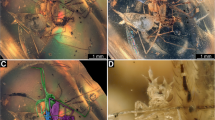Abstract
We report on the larviposition behaviours and life cycles of what appear to be the first known insect parasitoids of a marine mollusc. In the field, Sarcophaga megafilosia Pape, McKillup & McKillup and Sarcophaga meiofilosia Pape, McKillup & McKillup were seen depositing larvae close to live individuals of the intertidal snail, Littoraria filosa (Sowerby), which lives on the upper leaves and branches of mangroves. Once a larva had entered the shell, by wriggling between the operculum and the spire, it began burrowing into the foot of the snail. This caused the snail to retract violently and produce large amounts of mucus that entrapped and prevented other larvae present outside from entering the shell. Each snail died within an hour of larval penetration and its shell, within which the larva and pupa developed, became glued to a leaf or branch with dried mucus. S. megafilosia only larviposited on snails with shells 10 mm or longer, while S. meiofilosia only larviposited on those with shells from 4 to <10 mm long. Both flies were reared in the laboratory and had similar life cycles with a minimum generation time of about 50 days. Adults lived for up to 7 months and overwintered as adults; there was no evidence of a larval or pupal diapause.
The larviposition behaviours of these flies are contrasted with a sarcophagid parasitoid of terrestrial snails. We suggest that other sarcophagid parasitoids of littorinid snails may have been overlooked, and that visual selection of hosts by S. megafilosia and S. meiofilosia may be at least partly responsible for maintaining the shell colour polymorphism shown by L. filosa.
Similar content being viewed by others
References
Aubertin, D., A. E. Ellis & G. C. Robinson, 1930. The natural history and variation of the pointed snail, Cochlicella acuta (Müller). Proc. zool. Soc. Lond. (1930): 1027–1055.
Bequaert, J. C., 1925. The arthropod enemies of mollusks, with description of a new dipterous parasite from Brazil. J. Parasitol. 11: 201–212.
Cheng, L. (ed.), 1976. Marine Insects. North-Holland Publishing Company: 581 pp.
Cheng, L. & J. H. Frank, 1993. Marine insects and their reproduction. Oceanogr. mar. Biol. annu. Rev. 31: 479–506.
Colless, D. H. & D. K. McAlpine, 1991. Diptera. In Division of Entomology, Commonwealth Scientific and Industrial Research Organisation (ed.), Insects of Australia. Melbourne University Press, Melbourne: 717–786.
Cook, L. M., 1983. Polymorphism in a mangrove snail in Papua New Guinea. Biol. J. linn. Soc. 20: 167–173.
Cook, L. M., 1986. Polymorphic snails on varied backgrounds. Biol. J. linn. Soc. 29: 89–99.
Cook, L. M., 1992. The neutral assumption and maintenance of colour morph frequency in mangrove snails. Heredity 69: 184–189.
Coupland, J. B. & G. Baker, 1994. Host distribution, larviposition behaviour and generation time of Sarcophaga penicillata (Diptera: Sarcophagidae), a parasitoid of conical snails. Bull. ent. Res. 84: 185–189.
Denlinger, D. L., 1974. Diapause potential in tropical flesh flies. Nature 252: 223–224.
Denlinger, D. L. & M. Shukla, 1984. Increased length and variability of the life cycle in tropical flesh flies (Diptera: Sarcophagidae) that lack pupal diapause. Ann. ent. Soc. Am. 77: 46–49.
Hughes, J. M. & P. B. Mather, 1986. Evidence for predation as a factor in determining shell color frequencies in a mangrove snail Littorina sp. (Prosobranchia: Littorinidae). Evolution 40: 68–77.
McKillup, S. C. & R. V. McKillup, 1997. Effect of food supplementation on the growth of an intertidal scavenger. Mar. Ecol. Prog. Ser. 148: 109–114.
McKillup, S. C. & R. V. McKillup, 2000. The effects of two parasitoids on the life history and metapopulation structure of the intertidal snail Littoraria filosa in different-sized patches of mangrove forest. Oecologia 123: 525–534.
Pape, T., 1998. Sarcophagidae. In Papp, L. & B. Darvas (eds), Contributions to a Manual of Palaearctic/European Diptera. Science Herald, Budapest: 649–678.
Pape, T., S. C. McKillup & R. V. McKillup, 2000. Two new species of Sarcophaga Meigen subgenus Sarcorohdendorfia Baranov (Diptera: Sarcophagidae), parasitoids of Littoraria filosa (Sowerby) (Gastropoda: Littorinidae). Aust. J. Ent. 39: 236–240.
Povolný, D., 1992. Zum Schneckenparasitismus und zur Taxonomie einiger Sarcophagini-Arten (Diptera, Sarcophagiae). Acta Universitatis Agriculturae (Ser. A) 40: 169–185, (In German with English abstract.)
Povolný, D. & Y. Verves, 1997. The flesh-flies of Central Europe (Insecta, Diptera, Sarcophagidae). Spixiana Suppl. 24: 1–260.
Reid, D. G., 1985. Habitat and zonation patterns of Littoraria species (Gastropoda: Littorinidae) in Indo-Pacific mangrove forests. Biol. J. linn. Soc. 26: 39–68.
Reid, D. G., 1986. The littorinid molluscs of mangrove forests in the Indo-Pacific region. British Museum (Natural History), London: 227 pp.
Reid, D. G., 1987. Natural selection for apostacy and crypsis acting on the shell colour polymorphism of a mangrove snail, Littoraria filosa (Sowerby) (Gastropoda: Littorinidae). Biol. J. linn. Soc. 30: 1–24.
Robertson, A. I., 1991. Plant-animal interactions and the structure and function of mangrove forest ecosystems. Aust. J. Ecol. 16: 433–443.
Ross, P. M., 1996. Differences in morphology and reproduction of the barnacles Elminius covertus and Hexaminius spp. from mangrove forests in the Sydney region of New South Wales. Mar. Freshwat. Res. 47: 715–721.
Stegmaier, C. E., Jr. 1972. Notes on some Sarcophagidae (Diptera) reared from snails (Mollusca) in Florida. Florida Entomol. 55: 237–242.
Author information
Authors and Affiliations
Rights and permissions
About this article
Cite this article
McKillup, S.C., McKillup, R.V. & Pape, T. Flies that are parasitoids of a marine snail: the larviposition behaviour and life cycles of Sarcophaga megafilosia and Sarcophaga meiofilosia. Hydrobiologia 439, 141–149 (2000). https://doi.org/10.1023/A:1004104931474
Issue Date:
DOI: https://doi.org/10.1023/A:1004104931474




